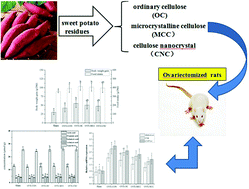Effect of the particle size of cellulose from sweet potato residues on lipid metabolism and cecal conditions in ovariectomized rats
Abstract
This study aims to examine the effect of the particle size of cellulose from sweet potato residues on lipid metabolism and cecal conditions in ovariectomized rats. Forty mature female Wistar rats were divided into five groups. The sham-operated group was used as the sham control. The other four groups were double-ovariectomized and assigned to the model, ordinary cellulose (100 g kg−1 diet), microcrystalline cellulose (100 g kg−1 diet), and cellulose nanocrystal (100 g kg−1 diet) groups. As the cellulose particle size decreased, the body weight gain and food intake were decreased. The plasma lipids and hepatic lipids were decreased. In addition, the mRNA levels of cholesterol 7α-hydroxylase, farnesoid X receptor, and 3-hydroxy-3-methylglutaryl coenzyme A reductase were decreased, whereas those of ileal apical sodium-dependent bile acid transporter and intestinal bile acid binding protein were increased. The cecum weight, cecum content, and short-chain fatty acid concentration and the amount of total bile acids in the small intestinal content, as well as the bile acids and neutral steroids in fecal excretion, were increased. These results indicate that as the particle size decreased, cellulose was more effective in preventing ovarian hormone deficiency-induced hyperlipidemia and in improving intestinal health.


 Please wait while we load your content...
Please wait while we load your content...